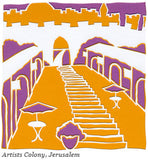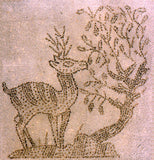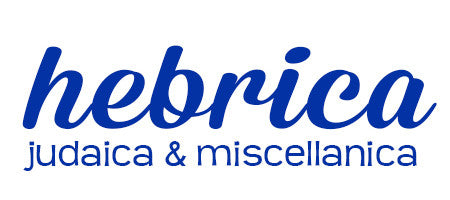 On a hot, hot summer day in Jerusalem, I stopped into a Judaica shop on King George Street to get out of the sun. I didn't know that brief respite would lead to a career.
On a hot, hot summer day in Jerusalem, I stopped into a Judaica shop on King George Street to get out of the sun. I didn't know that brief respite would lead to a career.
The Judaica shop had the usual Shabbat candlesticks, pomegranate salt-and-pepper shakers, and kippot. During my month-long stay in Jerusalem, I was overwhelmed with the amount of art in the city. A lot of the art activity in Israel is driven by tourism, to be sure, but not all. Everywhere you look, there are art galleries, shops selling the most gorgeous glass, sculpture, ceramics, jewelry and metalwork...all across Israel. And there are scribes and papercut artists, too.
 It was one particularly Jewish art form, micrography, that let me to papercut art. Outside this Judaica shop was an artist selling prints of his art, pictures made up of itty-bitty writing in Hebrew. Why micrography? The second commandment is interpreted by some as an absolute injunction against making "images." But if you make those images with Hebrew letters, you're simply writing! More about this ancient art form here. For more modern examples of micrography, take a look here. How that artist ~ I wish I remembered his name ~ changed my life in just a minute...
It was one particularly Jewish art form, micrography, that let me to papercut art. Outside this Judaica shop was an artist selling prints of his art, pictures made up of itty-bitty writing in Hebrew. Why micrography? The second commandment is interpreted by some as an absolute injunction against making "images." But if you make those images with Hebrew letters, you're simply writing! More about this ancient art form here. For more modern examples of micrography, take a look here. How that artist ~ I wish I remembered his name ~ changed my life in just a minute...
For a culture that originally shunned the notion of art, Jews are a creative bunch. The concept of micrography alone is example enough of a creative way to express oneself visually in spite of drawing a wide fence around a commandment that seems to forbid that. While we never, ever illuminate an actual Torah scroll, there are instances of tremendous creativity in the narrative.
The best example of creativity in Torah is in the building of the mishkan, the portable tabernacle that contained the ark of the covenant during the Israelites' trek through the desert. God asked Bezalel and his helper, Oholiab, "to devise skillful works, to work in gold, and in silver, and in brass, and in cutting of stones for setting, and in carving of wood, to work in all manner of workmanship" (Ex. 31:2 and following) to carve the ark and make all the appointments and ritual items of the mishkan--what an awesome responsibility! Given the importance of the work, we can only assume Bezalel carried it out with hiddur mitzvah, doing a commandment beautifully.
So, how did looking for a bit of shade in a Judaica shop in Jerusalem lead to a career in Jewish papercut art? The micrography artist picked up on my interest in scribal arts and suggested I go see a scribe living in the German Colony, who introduced me to the master papercutter in all of Israel; it was, in a way, beshert, meant to be. More about these two incredibly talented, dedicated, and generous artists here:
Izzy Pludwinski, scribal artist | Archie Granot, papercut artist
Today, the biblical tradition of creativity and craftsmanship continues at Bezalel Academy in Jerusalem; the beauty, antiquity and deep meaning of the land and its places inspire artists all over Israel. Take a look at these lovely images, and you'll be captivated, too...
Note: Another interpretation of the second commandment about "graven images" is that the Israelites are not to make those images for purposes of worshipping them as idols.
Subscribe to this blog at the bottom of the page.
___
Kim Phillips is a Judaica artist in Nashville, Tennessee. Click here for bio. If you'd like her to lead a papercut art workshop at your synagogue, religious school, Jewish day school or Jewish community center, click here for more information and here to contact her. Artist-in-residence programs available.

